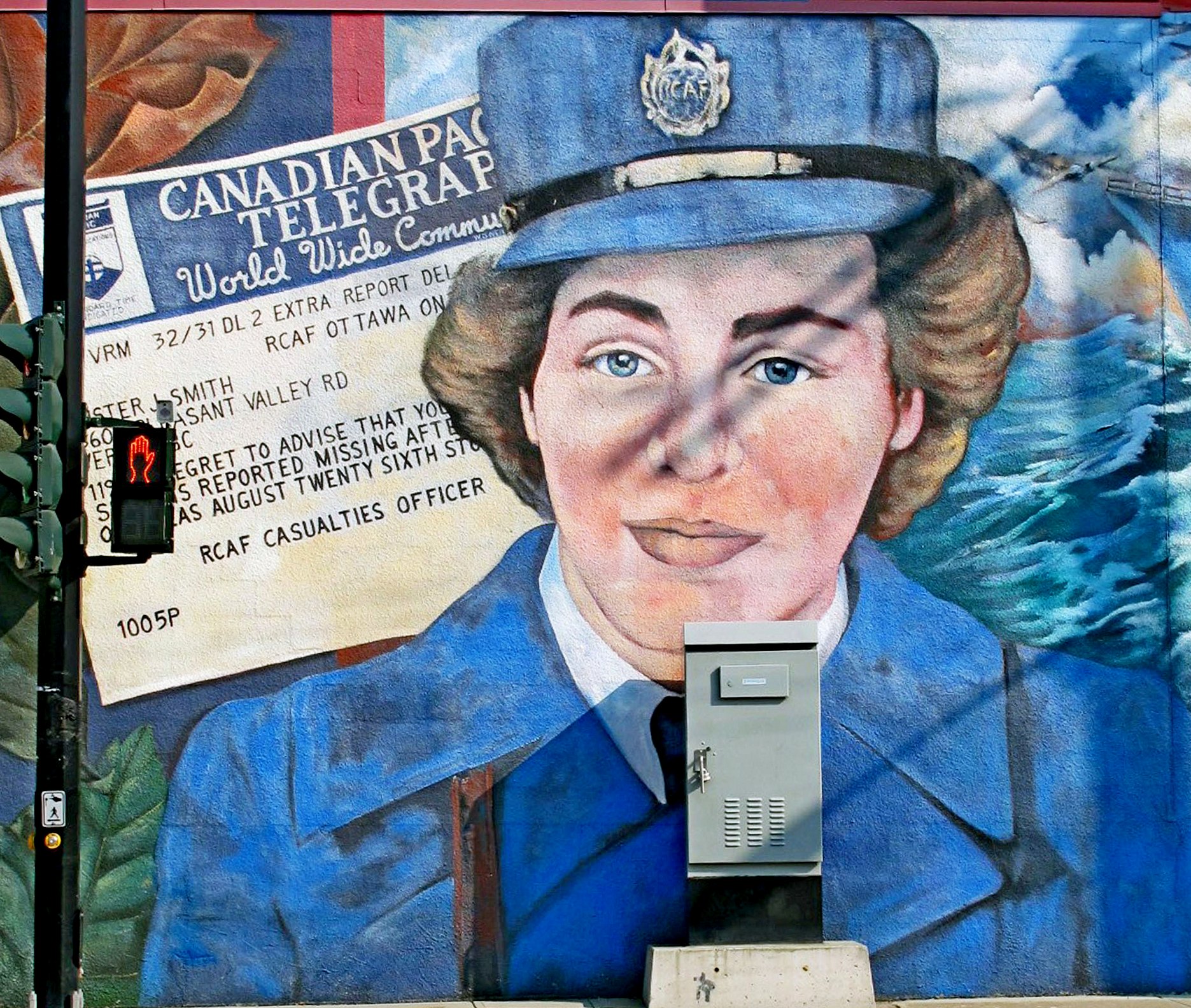|
 Canada - World War II - Vernon, British Columbia Posted by:  T0SHEA T0SHEA
N 50° 15.925 W 119° 16.487
11U E 337879 N 5570617
This remarkable mural about Canada's role in WW II is located on the side of Staples at the corner of 33rd Street and 32nd Avenue. View mural from 32nd Avenue. A walking tour guide is available at the visitor's centre.
Waymark Code: WMMMT0
Location: British Columbia, Canada
Date Posted: 10/11/2014
Views: 4
This mural is one of many that can be seen in Vernon. Canada - World War II shows scenes with the Canadian Air Force, Navy and Army during the war.
The "Official Extra" from the Vancouver Sun is being held by a young boy declaring "PEACE".
There is a partial passage from the poem, "For the Fallen" by Laurence Binyon. It was first published in The Times in September 1914.
They shall grow not old, as we that are left grow old:
Age shall not weary them, nor the years condemn.
At the going down of the sun and in the morning
We will remember them.
To read the entire poem, "For the Fallen":
From All Poetry
All the murals are well done paying tribute to the artist's talent and creativity for any passersby to enjoy.
We will showcase
Canada - World War II
![]() 
Canada's Role in WWII
From the Beginning...
Canada entered the 1939-1945 War on 10th September 1939. Within two months the first contingents of Canadian troops arrived in the United Kingdom to supplement the British Expeditionary Forces. Forestalled by the evacuation of the British Army from Dunkirk and the Channel ports, Canada's role became one of defense of the British Isles. Far across the globe a small force of Canadians arrived in Hong Kong in time to meet the Japanese invasion, and fought with the British, Indian and Hong Kong forces in defense of the colony until the surrender on Christmas Day 1941.
Dieppe
On l9th August 1942 troops of the Canadian 2nd Division formed the bulk of the Dieppe Raid. Of the 5,000 Canadians who took part, only about 2,000 returned to England: nearly 1,000 had been killed and 2,000 taken prisoner. A further 500 Canadians lost their lives when they landed in Sicily as part of the Eighth Army on July 10th 1943.
The Cost of Battle
On September 3rd a combined Canadian, British and American force made the first full-scale invasion of mainland Europe, attacking on the 'toe' of Italy and reaching Naples on October 1st. Canadian troops fought at Ortona and Monte Cassino and in May 1944 took part in the costly, but successful, attack on the Hitler line: the first major operation by a Canadian corps in the 1939-1945 War. The battle northwards through Italy continued to the war's end and ultimately cost the lives of nearly 6,000 Canadians.
Normandy
Landing in Normandy June 6th, 1944 as part of the Allied invasion force, the Canadians played an important role in the battle to take Caen. They then advanced along the French seacoast to the Pas-de-Calais and took Dieppe on September 1st. Canadians fought with British soldiers in the freeing of the Scheldt Estuary and success here enabled the first Allied convoy to arrive in Antwerp in November 1944.
Contributions on Land
Some Canadian units played a prominent part in the liberation of the Netherlands while others went on to participate in the Battle of Germany. In February 1945 the Canadian First Army attacked in the Reichswald Forest, and helped drive the Germans back across the Rhine; the German forces surrendered to General Montgomery on Luneburg Heath on May 5th, 1945. From D-Day to VE Day 12,500 Canadians died.
Contributions on the Sea
During the 1939-1945 War the Royal Canadian Navy grew to a strength of nearly 100,000 personnel and nearly 400 vessels. Their main duty was to act as convoy escorts across the Atlantic, in the Mediterranean and to Murmansk in the USSR. They also hunted submarines, and supported amphibious landings in Sicily, Italy and Normandy. In all the Royal Canadian Navy lost nearly 2,000 sailors.
Contributions in the Air
Although a major task of the Royal Canadian Air Force based at home was the hunting of U-Boats in the North Atlantic, its most important area of operations was Europe, where 48 Canadian squadrons served. The scale of their contribution was recognized on January 1st, 1943 by the formation of No. 6 Group, an Royal Canadian Air Force formation within Bomber Command. Canadian airmen fought in the Battle of Britain, North Africa, Italy and the Normandy invasion. About 17,000 died; the great majority while serving with Bomber Command.
From the Mount Allison University Library
The very first mural was created in the fall of 1998 and over the course of the next 15 years the lead artist, along with local youth, painted an additional 27 murals.
Downtown Vernon’s outdoor art gallery was made possible through funding from HRDC, investment by downtown businesses and local organizations, as well as the City of Vernon.
The Vernon Museum and Archives provided original content and photos.
The murals are visited by hundreds of people each year and continue to be a
wonderful way to tell Vernon’s story.
From the Downtown Vernon Murals
![]()
City: Vernon

Location Name: Staples

Artist: Michelle Laughery

Date: 2001

Media: Painted on stucco

Relevant Web Site: Not listed

|
Visit Instructions:
Please give the date and description of your visit. One original photo of the mural must also be submitted. GPSr photo NOT required.
|